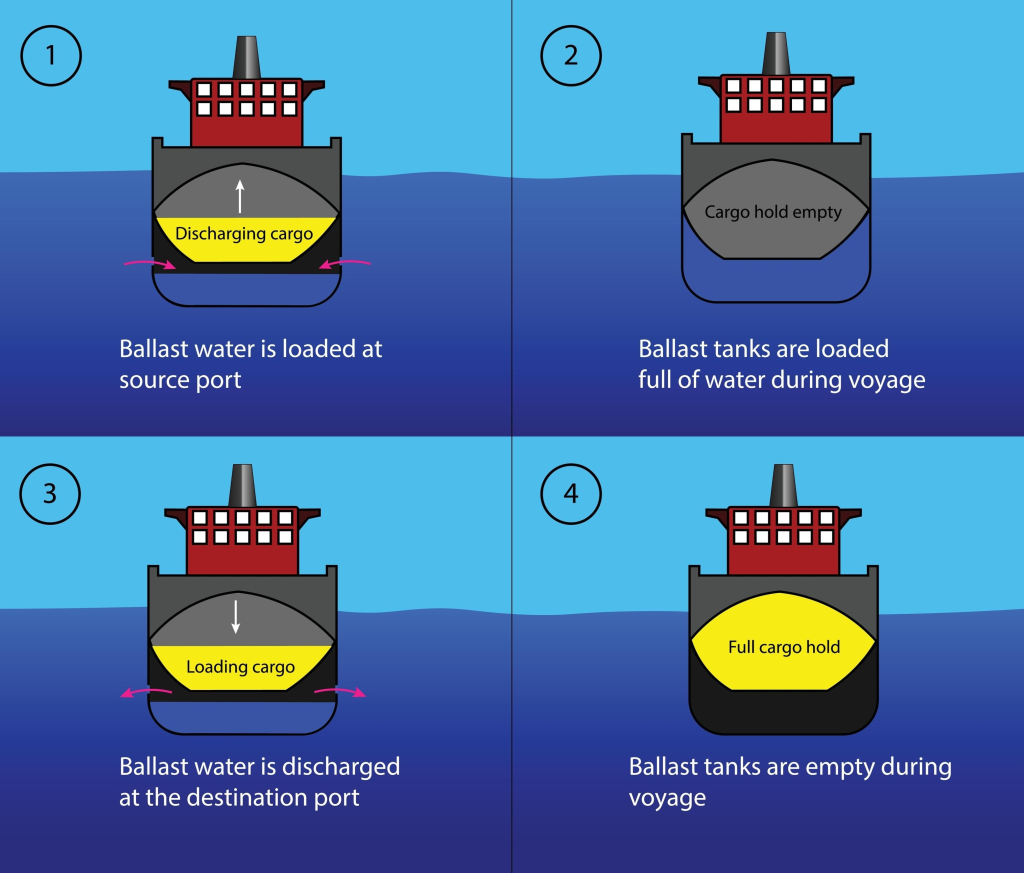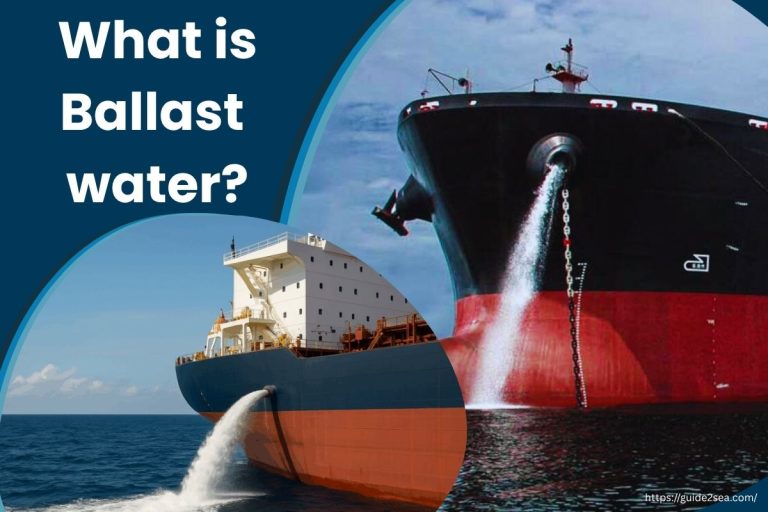Imagine you are carrying a box. You notice it feels unbalanced and tilting to one side. To balance it, you might add something heavy, such as a water bottle, an umbrella, or another item. Then you feel the box is stable, and you can carry it safely without dropping anything.
Ships work in a very similar way. Because ships are some of the largest and most important vehicles in the world. They carry millions of tons of cargo every year. But have you ever wondered how these massive ships stay balanced while crossing seas and oceans? The answer lies with ballast water.
Just like adding weight to your box, let’s see how ballast water maintains the balance of the ship.
What is Ballast Water?
Simply, Ballast water is water that is taken into a ship’s specialized tanks to help maintain its stability and balance. When a ship is not fully loaded with cargo, it may be too light to sail high in the water. This makes the ship unstable and dangerous, especially in rough seas. By taking in ballast water, a ship can adjust its weight and center of gravity, allowing it to sail safely and efficiently.
Ships store ballast water in specialized tanks or compartments within the hull. These tanks are called ballast tanks. They are built specifically for this purpose and can hold millions of liters of water. These tanks are located at the bottom or sides of a ship. Ships pump ballast water in or out to adjust for weight, cargo, and sea conditions.
Why Do Ships Need Ballast Water?
Ships carry different types of cargo. The weight of this cargo affects the stability of the ship. Sometimes, ships are not fully loaded, or cargo may be unevenly distributed. In these cases, ballast water is essential.
- Maintain Stability—A ship without enough weight may tilt, lean to one side, or roll excessively in waves. Ballast water helps balance the ship’s weight, ensuring it stays level.
- Enhance Safety—Rough seas, strong winds, and large waves can easily tip an unbalanced ship. By adjusting ballast water, ships reduce the risk of accidents.
- Protect Cargo—Properly balanced ships prevent containers and goods from shifting during the voyage. This ensures that cargo reaches its destination safely.
- Improve Fuel Efficiency—A ship that is not balanced may create more drag, consuming extra fuel. Ballast water helps maintain the optimal draft and trim, allowing the ship to move efficiently.
- Aid Navigation—Ballast water allows ships to maintain proper buoyancy, making steering easier and preventing damage to the hull.
In short, ballast water is not just water. It is a vital tool for the safety and smooth operation of ships. Without ballast water, even large, heavy ships could face serious accidents, cargo loss, or structural damage. It is one of the most basic yet critical aspects of modern shipping.
How Does Ballast Water Work?
Ballast water plays a crucial role in ensuring stability and safety at sea. The operation of ballast water is quite simple in principle but requires careful management.

Image Source:https://www.shutterstock.com/
- Uptake—Ships use special intake systems to take ballast water from the surrounding sea or port. When a ship unloads cargo at a port, it becomes lighter. Ships pump water into the ballast tanks to replace missing weight and maintain balance.
- Storage—Ships store the water in ballast tanks, which are designed to hold large quantities of water. This helps to maintain the stability and balance of the ship.
- Adjustment—The amount of ballast water helps to adjust the desired stability of the ship during the voyage. A vessel controls stability by pumping water in and out of its ballast tanks
- Discharge—When loading cargo, ships adjust their ballast by releasing water from the tanks. This keeps the ship at the correct draft. Ships carefully control ballast water discharge to protect the marine environment.
Modern ships often use computer-controlled ballast systems. These systems monitor water levels, weight distribution, and ship movement in real-time, automatically adjusting ballast water as needed. Careful management ensures that even a large cargo ship with thousands of containers remains stable in all sea conditions.
Types of Ballast Water
Not all ballast water is the same. Ships use different types of ballast water. Ballast water can be categorized based on its source, treatment, or usage. Understanding different types of ballast water is essential for effective ballast water management.
1. Based on Source
- Freshwater Ballast—Ships use freshwater ballast when operating in rivers, lakes, or canals. Inland waterway vessels. Ships visiting freshwater ports typically rely on this type of ballast water.
- Seawater Ballast—This is the most common type. Ships pump water from the ocean into their ballast tanks. Ships traveling long distances across the ocean commonly use this type of ballast water.
- Brackish Ballast—Ships use brackish ballast when operating in coastal areas where fresh and saltwater mix. Vessels in regions with varying salinity levels typically depend on this type of ballast water.
2. Based on Treatments
- Treated Ballast Water—Vessels use treatment systems to clean ballast water, eliminating harmful organisms and pathogens. Treatment technologies can include filtration, UV treatment, chemical treatment, and other technologies.
- Untreated Ballast Water—Untreated ballast water is ballast water that has not been treated. When disposing of this type of ballast water, it can be harmful for the marine environment.
3. Based on Usage
- Permanent Ballast—Ships use permanent ballast to provide long-term stability and balance. Cargo ships, tankers, and other vessels that need consistent stability typically rely on this type of ballast.
- Variable Ballast—Ships use variable ballast to adjust stability and balance according to changing operational conditions. Vessels that need flexible ballast operations, such as cruise ships and research vessels, typically rely on this type of ballast.
Each type has its advantages and challenges. Seawater ballast is widely used. But each type of ballast water requires careful treatment to prevent environmental damage.
What is the Future of Ballast Water in Shipping?
Stricter rules and new technologies will shape the future of ballast water in shipping. Ships will need to use advanced systems to treat ballast water before discharging it to prevent harming the environment. Digital tools will help track and manage ballast water, making it easier to comply with regulations.
The industry will prioritize sustainability, reducing the risk of invasive species and protecting marine ecosystems. As a result, shipowners will invest in better systems and practices, driving innovation and efficiency in ballast water management. Even today technologically advanced ports follow these methods.
Final Thought
Ballast water might look like ordinary seawater, but it is one of the most important elements of modern shipping. It keeps ships stable, protects cargo, ensures crew safety, and supports global trade. Ships must manage ballast water properly to protect marine ecosystems and prevent the spread of invasive species.
Without ballast water, shipping would be slow, unsafe, and inefficient. Next time, when you see a large container ship or tanker at sea, remember that billions of liters of water inside its tanks are quietly working to keep it balanced, safe, and ready to carry goods across the world.



